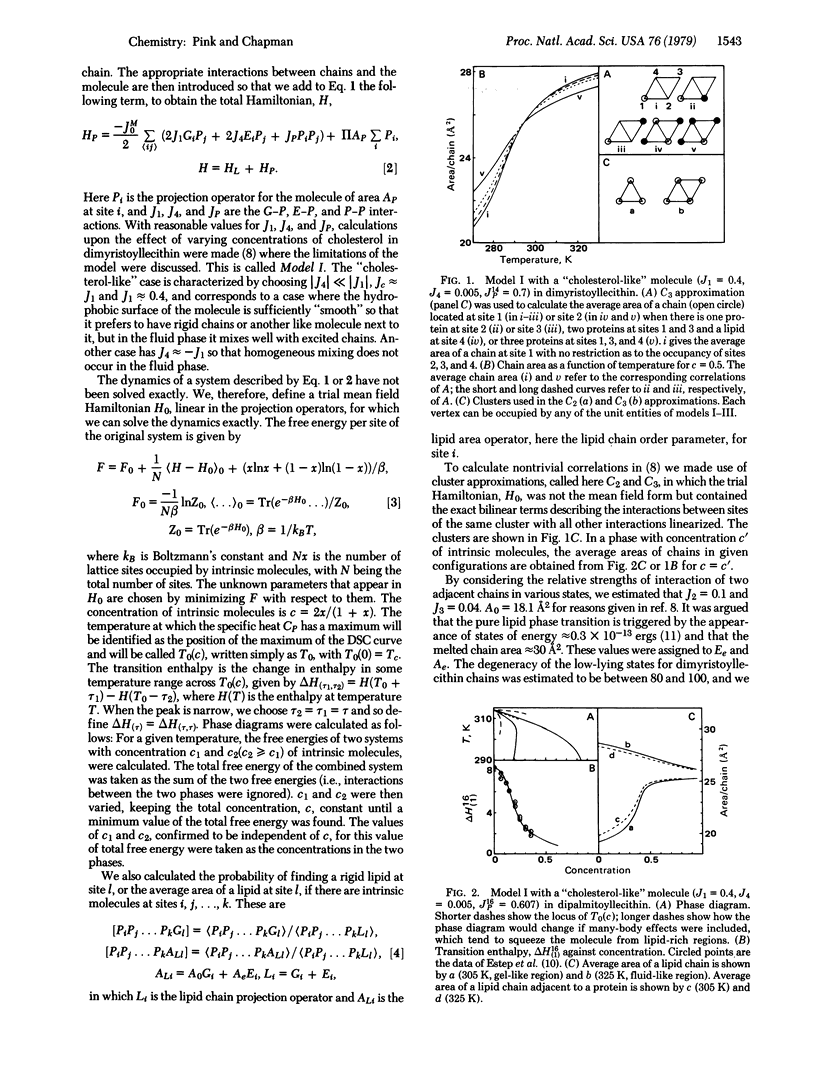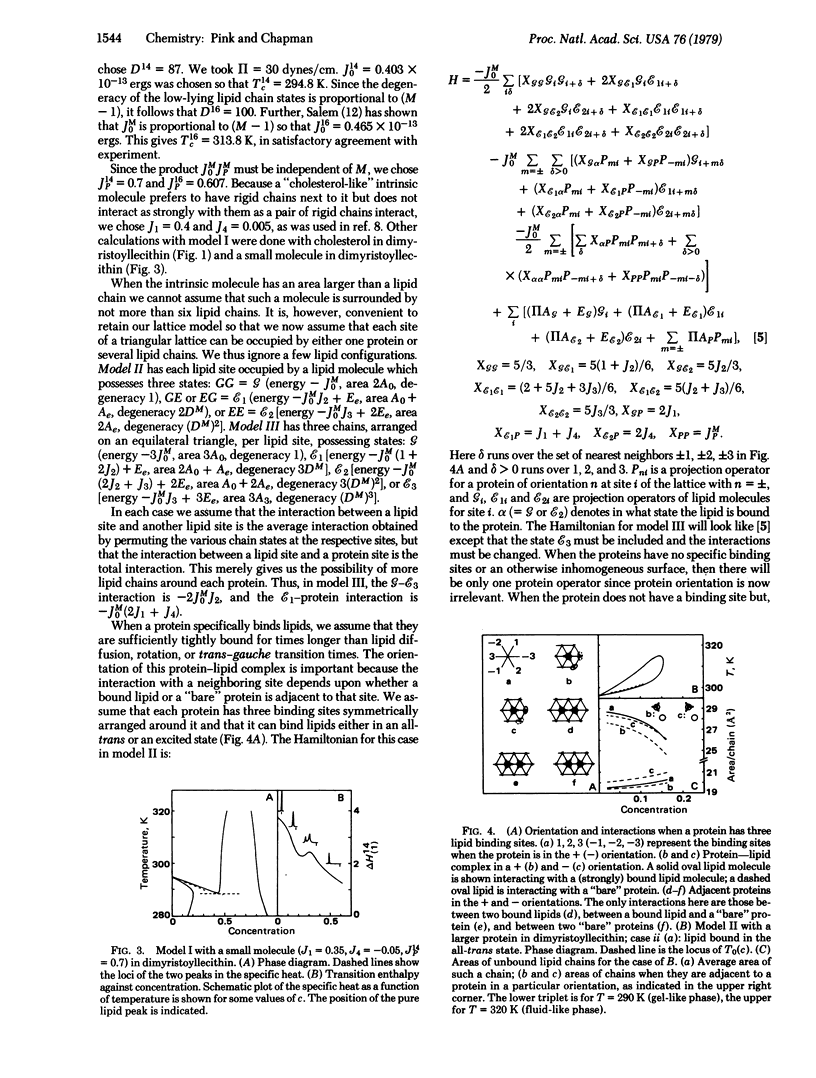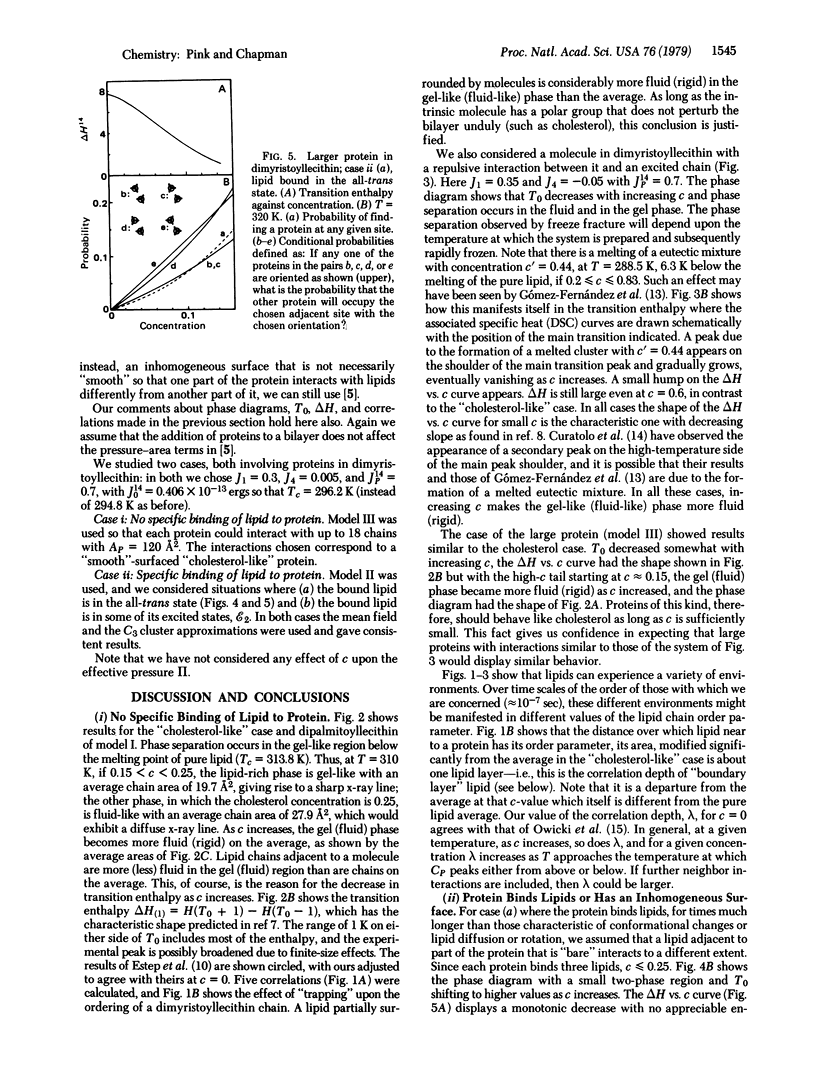Abstract
A lattice model has been developed to study the effects of intrinsic membrane proteins upon the thermodynamic properties of a lipid bilayer membrane. We assume that only nearest-neighbor van der Waals and steric interactions are important and that the polar group interactions can be represented by effective pressure—area terms. Phase diagrams, the temperature T0, which locates the gel—fluid melting, the transition enthalpy, and correlations were calculated by mean field and cluster approximations. Average lipid chain areas and chain areas when the lipid is in a given protein environment were obtained. Proteins that have a “smooth” homogeneous surface (“cholesterol-like”) and those that have inhomogeneous surfaces or that bind lipids specifically were considered. We find that T0 can vary depending upon the interactions and that another peak can appear upon the shoulder of the main peak which reflects the melting of a eutectic mixture. The transition enthalpy decreases generally, as was found before, but when a second peak appears departures from this behavior reflect aspects of the eutectic mixture. We find that proteins have significant nonzero probabilities for being adjacent to one another so that no unbroken “annulus” of lipid necessarily exists around a protein. If T0 does not increase much, or decreases, with increasing c, then lipids adjacent to a protein cannot all be all-trans on the time scale (10-7 sec) of our system. Around a protein the lipid correlation depth is about one lipid layer, and this increases with c. Possible consequences of ignoring changes in polar group interactions due to clustering of proteins are discussed.
Keywords: intrinsic molecules, phase transitions, boundary layers
Full text
PDF




Selected References
These references are in PubMed. This may not be the complete list of references from this article.
- Brûlet P., McConnell H. M. Protein-lipid interactions glycophorin and dipalmitolyphosphatidylcholine. Biochem Biophys Res Commun. 1976 Jan 26;68(2):363–368. doi: 10.1016/0006-291x(76)91153-0. [DOI] [PubMed] [Google Scholar]
- Chapman D., Cornell B. A., Ellasz A. W., Perry A. Interactions of helical polypepetide segments which span the hydrocarbon region of lipid bilayers. Studies of the gramicidin A lipid-water system. J Mol Biol. 1977 Jul 5;113(3):517–538. doi: 10.1016/0022-2836(77)90236-4. [DOI] [PubMed] [Google Scholar]
- Chapman D. Phase transitions and fluidity characteristics of lipids and cell membranes. Q Rev Biophys. 1975 May;8(2):185–235. doi: 10.1017/s0033583500001797. [DOI] [PubMed] [Google Scholar]
- Cornell B. A., Sacré M. M., Chapman D. The modulation of lipid bilayer fludity by intrinsic polypeptides and proteins. FEBS Lett. 1978 Jun 1;90(1):29–35. doi: 10.1016/0014-5793(78)80291-9. [DOI] [PubMed] [Google Scholar]
- Curatolo W., Sakura J. D., Small D. M., Shipley G. G. Protein-lipid interactions: recombinants of the proteolipid apoprotein of myelin with dimyristoyllecithin. Biochemistry. 1977 May 31;16(11):2313–2319. doi: 10.1021/bi00630a001. [DOI] [PubMed] [Google Scholar]
- Estep T. N., Mountcastle D. B., Biltonen R. L., Thompson T. E. Studies on the anomalous thermotropic behavior of aqueous dispersions of dipalmitoylphosphatidylcholine-cholesterol mixtures. Biochemistry. 1978 May 16;17(10):1984–1989. doi: 10.1021/bi00603a029. [DOI] [PubMed] [Google Scholar]
- Gershfeld N. L. Equilibrium studies of lecithin-cholesterol interactions I. Stoichiometry of lecithin-cholesterol complexes in bulk systems. Biophys J. 1978 Jun;22(3):469–488. doi: 10.1016/S0006-3495(78)85500-3. [DOI] [PMC free article] [PubMed] [Google Scholar]
- Hesketh T. R., Smith G. A., Houslay M. D., McGill K. A., Birdsall N. J., Metcalfe J. C., Warren G. B. Annular lipids determine the ATPase activity of a calcium transport protein complexed with dipalmitoyllecithin. Biochemistry. 1976 Sep 21;15(19):4145–4151. doi: 10.1021/bi00664a002. [DOI] [PubMed] [Google Scholar]
- Jost P., Griffith O. H., Capaldi R. A., Vanderkooi G. Identification and extent of fluid bilayer regions in membranous cytochrome oxidase. Biochim Biophys Acta. 1973 Jun 22;311(2):141–152. doi: 10.1016/0005-2736(73)90261-7. [DOI] [PubMed] [Google Scholar]
- Marcelja S. Lipid-mediated protein interaction in membranes. Biochim Biophys Acta. 1976 Nov 11;455(1):1–7. doi: 10.1016/0005-2736(76)90149-8. [DOI] [PubMed] [Google Scholar]
- Oldfield E., Gilmore R., Glaser M., Gutowsky H. S., Hshung J. C., Kang S. Y., King T. E., Meadows M., Rice D. Deuterium nuclear magnetic resonance investigation of the effects of proteins and polypeptides on hydrocarbon chain order in model membrane systems. Proc Natl Acad Sci U S A. 1978 Oct;75(10):4657–4660. doi: 10.1073/pnas.75.10.4657. [DOI] [PMC free article] [PubMed] [Google Scholar]
- Owicki J. C., Springgate M. W., McConnell H. M. Theoretical study of protein--lipid interactions in bilayer membranes. Proc Natl Acad Sci U S A. 1978 Apr;75(4):1616–1619. doi: 10.1073/pnas.75.4.1616. [DOI] [PMC free article] [PubMed] [Google Scholar]


